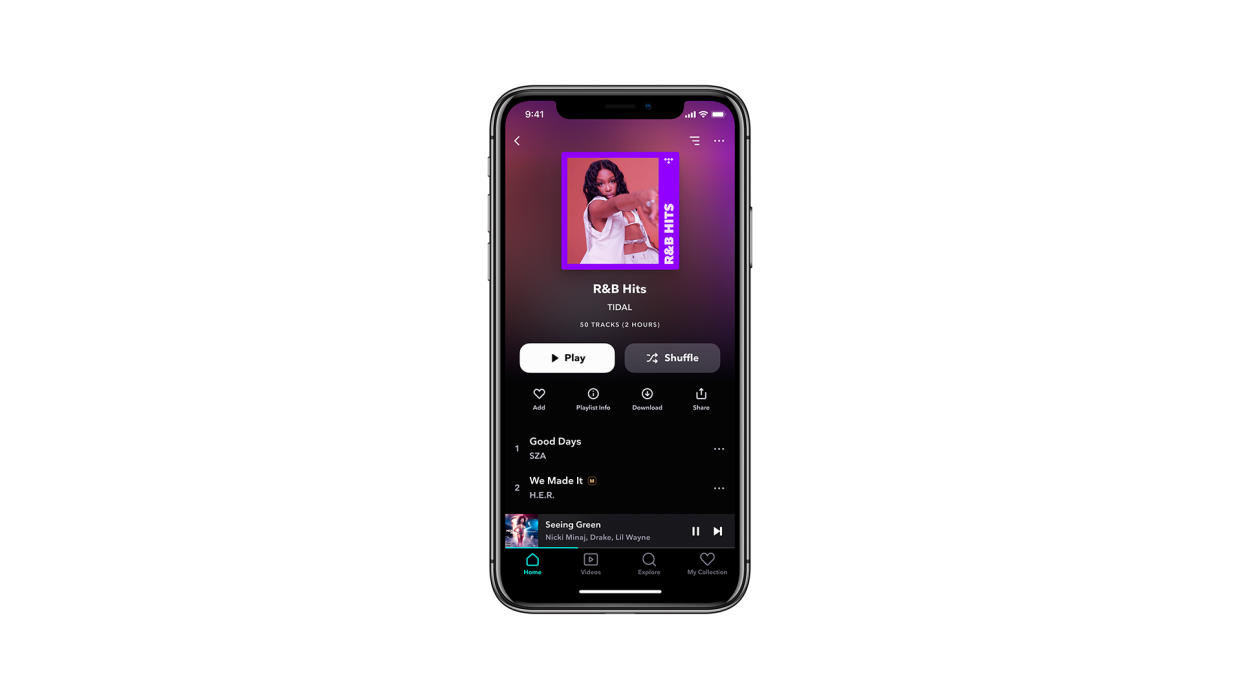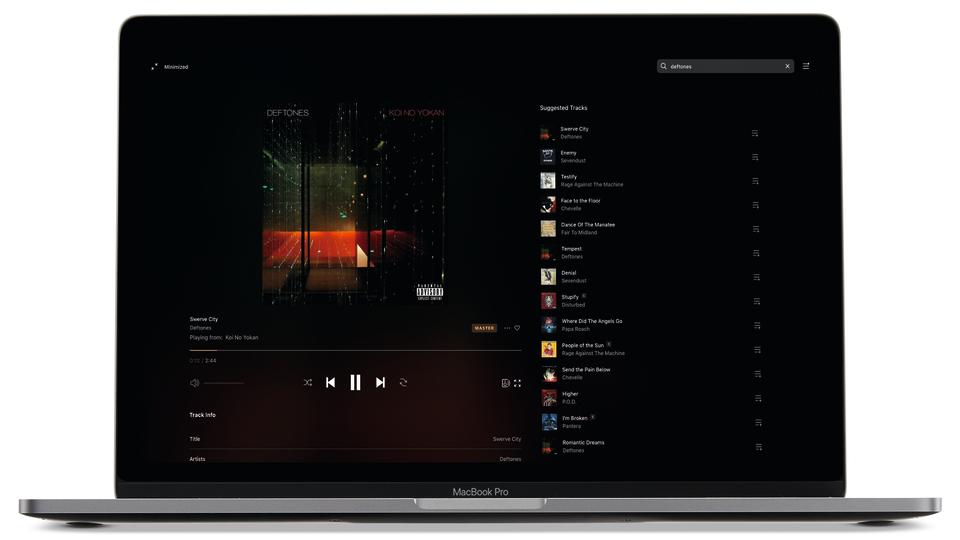Tidal

Tidal has been riding an encouraging wave of momentum since its celebrity-studded re-launch back in March 2015 – not least because, five years ago, it became the first service to offer hi-res audio streaming thanks to its adoption of MQA technology.
Nine years later, Tidal is ditching MQA – but it does still offer hi-res streaming up to 192kHz via the FLAC format, which is compatible with more music streamers and hi-fi hardware due to its open-source nature.
Of course, Tidal is far from the only hi-res music streaming service today, with Qobuz, Amazon Music and Apple Music also offering better-than-CD-quality streams. Spotify HiFi bringing CD quality sometime in the near future will only intensify the competition too. So, is Tidal still number one?
Price
In April 2024, Tidal simplified its subscription tiers to align with the competition, making its hi-res and spatial audio offerings much more affordable.
While access to 24-bit hi-res streams and Dolby Atmos Music and Sony 360 Audio tracks used to be locked within a £19.99 / $19.99 / AU$23.99 'HiFi Plus' tier, with CD-quality streaming offered in a £9.99 / $9.99 / AU$11.99 'HiFi’ one, there is now just one individual subscription plan costing £11 / $11 / AU$11 per month. This price matches Apple Music and Amazon Music, meaning Tidal is no longer the priciest hi-res streaming service out there.
Tidal's Family plan, for up to six family members, now costs £17 / $17 / AU$17 per month, while the Student Plan, offering the same as the Individual plan, has been discounted by 50 per cent and now costs just £5 / $5 / AU$5.
Tidal has now also scrapped its free tier, which it introduced in the US in November 2021.
Features
As well as being accessible via its PC and Mac desktop apps, web player (subscribers need Chrome or Firefox for lossless CD-quality sound) and Android and iOS mobile apps, Tidal has also expanded into Apple and Android TV apps as well as Apple CarPlay.
Tidal apps also form part of several networked hi-fi products’ offerings, from Sonos, Bluesound and DTS Play-Fi platforms to Linn, McIntosh, Naim and Cyrus streaming products. Google Chromecast supports Tidal too, while Tidal Connect – a similar concept to Spotify Connect – also allows for easy streaming to compatible products from within the native Tidal app. Tidal Connect supports hi-res FLAC and Dolby Atmos Music streams.
Tidal's hi-res FLAC library can also be played via the service's desktop, web, Android and iOS platforms, as well as being supported by several hi-fi components (either natively or via Tidal Connect) and software platforms like Roon.
In addition to offering a competitive song library well into the millions, Tidal (like Amazon Music) also boasts a growing catalogue of Dolby Atmos Music tracks. (Apple Music also offers Atmos-powered 'spatial audio' streams.) These immersive audio tracks can be played through headphones connected to an Atmos-compatible phone and tablet, or – to truly take advantage of the surround sound effect – an Atmos-enabled TV, soundbar or AVR connected to a compatible streamer running the most recently updated Tidal app. These supported streamers include the Apple TV 4K, Amazon Fire TV Stick 4K, Fire TV Cube (1st and 2nd gens), Fire TV Stick (3rd gen), Nvidia Shield TV and Nvidia Shield TV Pro (2019 or newer). Some Android TVs from Sony and Philips also natively support Dolby Atmos Music on Tidal.
Tidal's Android and iOS apps also supported Sony's 360 Reality Audio immersive audio format, though the service has announced they will no longer be available from July 2024.
Ease of use

We originally noted that hi-res tracks and albums could be hard to find on Tidal's interface, but the service has worked to make this much less of a sore spot by offering a growing number of hi-res playlists and increasing discovery of the hi-res library. Hi-res-specific playlists can be genre-specific, and there are now 'New Arrivals’ and 'Essentials’ playlists, artist-specific ones, plus artist and track 'Radio' stations, which allow subscribers to listen to an uninterrupted stream of hi-res tracks based on their listening habits.
The streaming service’s layout is exemplary, too. The desktop app's large number of tabs has been reduced to match the smartphone app, with the majority of content now grouped under the catch-all 'Home' tab.
Here you'll find your 'Recently Played' content, allowing you to quickly hop back into an album or playlist, while 'Recommended New Tracks' and 'Suggested New Albums for you' guide you to the latest new releases that Tidal's algorithms believe will be up your street. 'Custom Mixes' is also algorithm-led, serving up genre-specific mixes based on your listening habits.
Tidal appears to have taken a leaf out of Spotify's book by prioritising the discovery of new music tailored to your tastes, and it does so effectively. Just a few weeks of listening and favouriting is enough to start getting worthwhile recommendations.
Away from 'Home', the two main tabs are 'Explore' (which offers a broader canvas of genres and 'mood' categories you can dive into), and 'Videos' (which hosts, er, videos – music videos, video interviews, short films and the like). The final tab is 'My Collection', which groups all of your favourited music and custom playlists and also houses your downloads.
Tidal has also partnered with Tune My Music and Soundiiz to offer two ways of importing playlists from other streaming services, meaning you needn't drag and drop everything again if you're migrating from one of its rivals.
Performance

Whether you’re listening to CD-quality or hi-res streams, Tidal sounds great compared to its rivals.
Before Tidal upgraded its audio quality, we noted that its 320kbps streams just pip their Spotify and Deezer equivalents with a slightly richer, fuller-bodied sound. As you might expect, tracks streamed in CD quality (not to mention hi-res) offer much more detail, a better sense of space and a tighter handle on timing than their 320kbps counterparts.
In America’s Sister Golden Hair, the catchy guitar chords are fuller and ring truer with more twang. Harmonies sound like they’re being sung with greater enthusiasm, and the bells underneath are less hollow-sounding.
Hi-res FLAC tracks increase the level of insight again, prizing open the soundstage and giving the bare acoustic strumming in Christopher Stapleton’s A Simple Song greater freedom of movement. It digs up more inflections in the accompanying vocals, too.
Play the hi-res version of Dear Life by Beck and the piano-led rhythm is executed more precisely than the CD-quality version. And that organisation and punctuality put Tidal’s Masters just ahead of the hi-res streams offered by rivals Qobuz and Amazon Music, which lack a little sonic cohesion in comparison.
Amazon Music does counter with an occasionally more open and detailed delivery, but it's the Tidal streams that are most musical. Apple Music's ALAC (Apple Lossless Audio Codec) streams match Tidal for openness and subtlety and, actually, we noted how they can sound just a touch clearer.
Verdict
Where Tidal's MQA-powered hi-res streams were once a niche sub-section of the service's offering, its hi-res catalogue is now much bigger and much easier to take advantage of thanks to the introduction of FLAC streams, improved discovery features and the Tidal Connect feature.
The arrival of Amazon and Apple's more affordable hi-res offering was no doubt why Team Tidal rethought its tier and pricing structure (and for the better too).
Right now, we believe Apple Music is the most attractive and best-value hi-res streaming service out there... for Apple device owners. For Amazon Prime subscribers, Amazon Music is offered at an attractive discount. But for those looking for superior music streams who are not in Apple or Amazon's camp – especially those who own Tidal Connect-supporting gear – Tidal is still the music streaming service we can most heartily recommend.
SCORES
Performance 5
Features 5
Ease of use 5
MORE:
See all the current What Hi-Fi? Awards winners
Everything we know about the upcoming Spotify HiFi tier
Our pick of the best hi-res albums on Tidal
Hi-res music streaming services compared: which should you sign up for?
